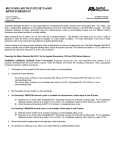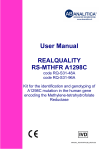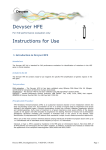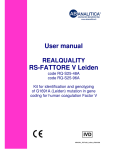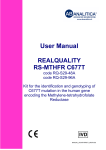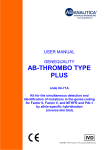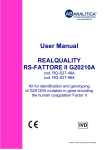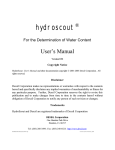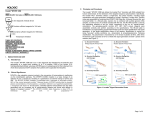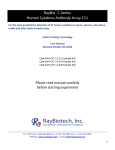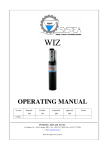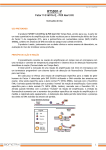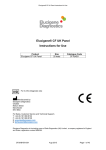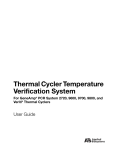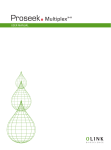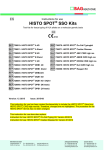Download Devyser Thrombophilia Art. No.
Transcript
Devyser Thrombophilia Art. No.: 8-A035 For in-vitro Diagnostic Use Instructions for Use Devyser Thrombophilia, CE-IVD, 7-A030-EN, v.4-2014 © Devyser AB, 2014 Page 1 of 27 Table of Contents Table of Contents 1. Introduction to Devyser Thrombophilia Intended Use Included in the Kit Test Procedure Background Principle of the Procedure 2. Warnings and Precautions 3. Symbols used on Labels 4. Required Material 4.1 Included in the kit Configuration Components 4.2 Required but not Provided Reagent Preparation DNA Extraction Amplification Detection Size Standard 4.3 Dye-Set Calibration 5. Storage and Handling Requirements 6. Sample Requirements Clinical Samples DNA Extraction and Measurement Procedure and Storage 7. Instructions for Use 7.1 Workflow Devyser Thrombophilia 7.2 Sample Preparation and PCR Amplification Sample Preparation Addition of Sample Amplification 7.3 Detection Sample Preparation Sample Preparation for Capillary Electrophoresis Instrument Preparation Run Modules 8. Data Analysis Background to data analysis 8.1 The Devyser Thrombophilia kit Devyser Thrombophilia, CE-IVD, 7-A030-EN, v.4-2014 © Devyser AB, 2014 2 4 4 4 4 4 5 6 7 8 8 8 8 8 8 8 8 8 8 9 10 11 11 11 11 12 12 12 12 12 13 14 14 14 14 14 16 16 16 Page 2 of 27 Normal alleles Mutant alleles 8.2 Data interpretation Normal (non mutated) alleles Heterozygous mutation Homozygous mutation Peak cutoff signals (rfu) Sizing of DNA fragments Table 1. Normal alleles detected Table 2. Mutant alleles detected 8.3 Troubleshooting PCR Artefacts Electrophoretic Artefacts 9. Performance Characteristics Sensitivity Specificity Reproducibility Within run reproducibility Between run reproducibility Clinical Evaluation Cross Reactivity 10. Procedural Limitations 11. Notice to Purchaser 12. References 13. Contact Information Devyser Thrombophilia, CE-IVD, 7-A030-EN, v.4-2014 © Devyser AB, 2014 16 16 16 16 16 16 16 18 18 19 19 19 19 21 21 21 21 21 21 22 23 24 25 26 27 Page 3 of 27 1. Introduction to Devyser Thrombophilia Intended Use The Devyser Thrombophilia kit is an in vitro diagnostic product for qualitative detection of genetic variants that may be associated with thrombophilia. The test can distinguish between individuals who are heterozygote and homozygote for all tested genetic variants. The following alleles are detected: - Factor V Leiden (normal and mutated) - Factor V R2 (normal and mutated) - Prothrombin/FII 20210 (normal and mutated) - MTHFR 677 (normal and mutated) - MTHFR 1298 (normal and mutated) - PAI-1/Serpin 1 (4G and 5G) Included in the Kit Analysis of the different alles is performed using one single amplification mix (Thromb Mix). Test Procedure DNA extraction: The Devyser Thrombophilia kit has been validated using QIAamp DNA Blood Mini Kit (Qiagen, cat.# 51104) for extraction of DNA from human whole blood. Amplification: The Devyser Thrombophilia kit has been validated using Life Technologies/ABI GeneAmp® System 9700 and Life Technologies Veriti® Thermal cycler. Detection: Life Technologies/ABI Genetic Analyzers (ABI 310, 3100, 3130, 3500, 3730) that support detection of Devyser Dye-Set DEV-5. Background Thrombophilia is caused by abnormalities in blood coagulation that increases the risk of thrombosis (1, 2). These abnormalities are frequently seen in patients who have an episode of thrombosis that was not provoked by other causes (3). A significant proportion of the population has a detectable abnormality, but most of these only develop thrombosis in the presence of an additional risk factor (2). Congenital thrombophilia is frequently caused by mutations in genes coding for coagulation factors such as factor V Leiden and prothrombin (1, 4, 5). Common conditions associated with thrombophilia are deep vein thrombosis (DVT) and pulmonary embolism (PE), collectively referred to as venous thromboembolism (VTE). Thrombophilia has also been linked to recurrent miscarriage (6, 7). Devyser Thrombophilia, CE-IVD, 7-A030-EN, v.4-2014 © Devyser AB, 2014 Page 4 of 27 Principle of the Procedure The Devyser Thrombophilia kit is based on multiplex allele specific PCR amplification for detection of normal, (non-mutated) and mutated alleles in the following loci: - Factor V Leiden - Factor V R2 - Prothrombin/FII 20210 - MTHFR 677 - MTHFR 1298 - PAI-1/Serpin 1 4G/5G Allele specific PCR amplification generates fluorescently labelled fragments that are analysed by capillary electrophoresis (CE) on a Genetic Analyzer instrument. Amplified fragments are identified based on size and fluorescent labels. Devyser Thrombophilia, CE-IVD, 7-A030-EN, v.4-2014 © Devyser AB, 2014 Page 5 of 27 2. Warnings and Precautions A. Devyser Thrombophilia has been validated using a total PCR reaction volume of 12,5 µL. Changing the reaction volume will compromise the kit performance. B. Avoid microbial contamination of ragents when removing aliquots from reagent vials. The use of sterile disposable aerosol barrier pipette tips is recommended. C. Do not pool reagents from different lots or from different vials of the same lot. D. Do not use a kit after its expiry date. E. Do not use opened or damaged kit reagent vials. F. Work flow in the laboratory should proceed in a unidirectional manner, beginning in the reagent preparation area and moving to the DNA extraction area and then to the amplification area and finally to the detection area. Pre-amplification activities should begin with reagent preparation and proceed to DNA extraction. Reagent preparation activities and DNA extraction activities should be performed in separate areas. Supplies and equipment should be dedicated to each activity and not used for other activities or moved between areas. Gloves should be worn in each area and should be changed before leaving that area. Equipment and supplies used for reagent preparation should not be used for DNA extraction activities or for pipetting or processing amplified DNA or other sources of target DNA. Amplification and detection supplies and equipment should remain in the amplification and detection area at all times. G. Handling of kit components and samples, their use, storage and disposal should be in accordance with the procedures defined by national biohazard safety guidelines or regulations. H. Wear powder free disposable gloves, laboratory coats and eye protection when handling specimens and kit reagents. Wash hands thoroughly after handling specimens and kit reagents. Devyser Thrombophilia, CE-IVD, 7-A030-EN, v.4-2014 © Devyser AB, 2014 Page 6 of 27 3. Symbols used on Labels Lot or batch number Expiry date Number of tests Store below temperature shown Catalogue number Manufacturer In vitro diagnostic device Devyser Thrombophilia, CE-IVD, 7-A030-EN, v.4-2014 © Devyser AB, 2014 Page 7 of 27 4. Required Material 4.1 Included in the kit Configuration The Devyser Thrombophilia test kit contains reagents for analysis of 48 samples. Components Cap Colour Orange Turquoise Tube Colour Clear Amber Label PCR Activator Thromb Mix Art.Nr. 4-A018 4-A213 Kit Content 1 1 4.2 Required but not Provided Reagent Preparation · Consumables for the Thermal Cycler · Micropipette/dispenser with aerosol barrier tips or displacement tips · Disposable protective gloves (powder free) DNA Extraction · Reagents and equipment according to manufacturer's instructions for use · Micropipette/multipipette with aerosol barrier tips Amplification · Thermal Cycler: Life Technologies/ABI GeneAmp® PCR System 9700 and Life Technologies Veriti® Thermal cycler. For use of alternative thermal cyclers the following ramping rates must be applied: heating 1,6 ˚C/s, cooling 1,6 ˚C/s · Micropipette/dispenser with aerosol barrier tips or displacement tips Detection · Life Technologies/ABI Genetic Analyzer (ABI 310, 3100, 3130, 3500, 3730) · Performance optimized polymers: POP-4™ or POP-7™ · Hi-Di™ Formamide, Genetic Analysis Grade · 1x Genetic Analyzer Buffer · Micropipette/multipipette/dispenser with aerosol barrier tips or displacement tips Size Standard 560 SIZER ORANGE (Devyser cat.# 8-A402) or GeneScan™ 600 LIZ® Size Standard (Life Technologies cat.# 4366589) Devyser Thrombophilia, CE-IVD, 7-A030-EN, v.4-2014 © Devyser AB, 2014 Page 8 of 27 4.3 Dye-Set Calibration ABI 3100, 3130, 3730: Use DEV-5 Dye-Set MultiCap kit (Devyser cat.# 8-A401) in the “Any5Dye” Dye-Set. ABI 3500: Use DEV-5 Dye-Set MultiCap kit (Devyser cat.# 8-A401) and generate the DEV-5 Dye-Set. ABI 310 Matrix file generation: Use DEV-5 Dye-Set SingleCap kit (Devyser cat.# 8-A400). Run with module file “GS STR POP4 (1 mL) G5.md5” Detailed instructions for Dye-Set calibration may be downloaded from the download section at: http://www.devyser.com/qf-pcr-accessories/dev-5-calibrators. Devyser Thrombophilia, CE-IVD, 7-A030-EN, v.4-2014 © Devyser AB, 2014 Page 9 of 27 5. Storage and Handling Requirements A. Store all components below -18 °C. B. The activated reaction mix (prepared by addition of Thromb Mix to the PCR Activator tube) may be stored at +2 to +8 °C for at least 7 days and at below -18 °C for at least 90 days. Avoid repeated freeze-thawing. C. Dispose of unused reagents and waste in accordance with country, federal, state and local regulations. D. Do not mix reagents from different kit lot numbers. Devyser Thrombophilia, CE-IVD, 7-A030-EN, v.4-2014 © Devyser AB, 2014 Page 10 of 27 6. Sample Requirements Clinical Samples The Devyser Thrombophilia kit is for use with human genomic DNA extracted from whole blood. DNA Extraction and Measurement Preparation of DNA from whole blood samples Results are consistently obtained with DNA extracted from human whole blood using QIAamp DNA Blood Mini Kit (Qiagen, cat.# 51104). Follow the protocol starting with 200 μL fresh whole blood and elute in 200 μL elution buffer. It is normally not necessary to determine the concentration of the purified DNA sample if this procedure is followed. The purified DNA can be used directly for PCR without any further dilution. It is recommended that alternative DNA extraction methods and sample materials are thoroughly evaluated with the Devyser Thrombophilia kit prior to the results being used for diagnostic use. For the recommended PCR conditions and analysis settings (see sections 7.2- 7.3), results are consistently obtained at DNA concentrations between 25 and 150 ng/PCR reaction (10 - 60 ng genomic DNA/µL sample). All DNA concentrations referred to in this handbook were determined using Qubit® dsDNA HS Assay Kit (Life Technologies, cat.# Q32851). The DNA concentration determined in a sample using Qubit® dsDNA HS Assay Kit may differ from the DNA concentration determined by other methods. Procedure and Storage According to manufacturer’s instructions for use. Devyser Thrombophilia, CE-IVD, 7-A030-EN, v.4-2014 © Devyser AB, 2014 Page 11 of 27 7. Instructions for Use 7.1 Workflow Devyser Thrombophilia Each Devyser Thrombophilia kit (art.# 8-A035) contains reagents for 48 samples. The activated reaction mix should be prepared before preparing the DNA samples if the complete process is performed in one day. The opposite order is advisable only if the DNA samples are prepared the day before amplification or earlier. The activated reaction mix is prepared by adding the Thromb mix to the PCR Activator. It is recommended that the activated reaction mix is dispensed into appropriate PCR reaction tubes after preparation. Before dispensing ensure that the activated reaction mix is properly mixed (see below). Dispense in 10 µL aliquots and store at below – 18 °C. Devyser Thrombophilia has been validated using a total PCR reaction volume of 12,5 µL. Changing the reaction volume will compromise the kit performance. Ensure that the Thromb mix is completely thawed before use. 1. Centrifuge each tube briefly to collect the content. Do not vortex the tubes at this step. 2. Add 500 µL from the Thromb mix to the PCR Activator. 3. Carefully mix by pipetting several times from the bottom of each tube. 4. Vortex the activated reaction mix tube and centrifuge briefly to collect the content. 5. Add 10 µL of the activated reaction mix to separate PCR reaction tubes. 6. Cap the reaction tubes and centrifuge briefly to collect the contents. 7. Continue to step 7.2. The activated reaction mix is stable at +2-8 °C for at least 7 days and at below -18 °C for at least 90 days. Avoid repeated freeze-thawing. 7.2 Sample Preparation and PCR Amplification Sample Preparation It is recommended that alternative DNA extraction methods and sample materials are thoroughly evaluated with the Devyser Thrombophilia kit prior to the results being used for diagnostic use. For the recommended PCR conditions and analysis settings (see below), results are consistently obtained at DNA concentrations between 25 and 150 ng/PCR reaction (10- 60 ng genomic DNA/µL sample). See also section 6. Addition of Sample Samples and controls should be added in a dedicated area separated from reagent preparation, amplification and detection areas. Devyser Thrombophilia, CE-IVD, 7-A030-EN, v.4-2014 © Devyser AB, 2014 Page 12 of 27 1. Add 2,5 µL of clinical sample (10 - 60 ng genomic DNA/µL sample) to each PCR reaction tube containing activated Thrombo mix (from step 7.1) 2. Cap the tubes and centrifuge briefly to collect the content. Amplification The Devyser Thrombophilia kit has been validated using Life Technologies/ABI GeneAmp® System 9700 and Life Technologies Veriti® Thermal cycler. Other PCR instruments should be tested and evaluated for optimal performance by the user before reporting results obtained with the Devyser Thrombophilia kit. PCR instruments should be regularly calibrated and maintained to ensure accurate PCR performance. For Life Technologies GeneAmp® PCR System 9700: Set “ramp speed” to “MAX”. For Life Technologies Veriti® Thermal cycler: In the "Tools Menu" select "Convert a Method". In the next step select "9700 Max Mode" and then enter the PCR profile as outlined below. Other thermal cyclers: The following ramping rates must be applied: heating 1,6 ˚C/s, cooling 1,6 ˚C/s. Amplification Area: Program the Thermal Cycler for amplification according to the following thermal profile (consult the User´s Manual for additional information on programming and operation of the thermal cycler): 95°C 15 min 94°C; 0,5 min -> 62°C; 1 min -> 72°C; 1 min for 25 cycles 72°C 15 min 4°C FOREVER Devyser Thrombophilia, CE-IVD, 7-A030-EN, v.4-2014 © Devyser AB, 2014 Page 13 of 27 1. Set reaction volume to 13 µL. 2. Set the appropriate ramping rates (heating 1,6 ˚C/s, cooling 1,6 ˚C/). 3. Start the amplification (duration approximately 2,5 hrs). 4. Following amplification, remove the tubes containing completed PCR amplification reaction from the thermal cycler and place into a suitable holder. Centrifuge briefly to collect the content. Remove the caps carefully to avoid aerosol contamination. Do not bring amplified material into the pre-amplification areas. Amplified material should be restricted to amplification and detection areas. 7.3 Detection Sample Preparation Refer to the respective Life Technologies/ABI Genetic Analyzers User Manual for instructions on maintenance and handling. Prior to running the Devyser Thrombophilia kit, the instrument must be spectrally calibrated to support detection of the Dye-Set DEV-5. See section 4.3 for details. Sample Preparation for Capillary Electrophoresis 1. Prepare a loading cocktail by combining and mixing 2 µL of the size standard (e.g. 560 SIZER ORANGE) with 100 µL Hi-DiTM Formamide (sufficient mix for 6 wells/tubes). 2. Vortex for 15 seconds. 3. Dispense 15 µL of the loading cocktail into the required number of wells of a microwell plate or into individual tubes to be placed on the Genetic Analyzer. 4. Add 1,5 µL of the sample PCR product to the corresponding well/tube containing loading cocktail. 5. Seal the plate/tubes. Instrument Preparation Create a sample sheet using the data collection software with the following settings: l l l Sample ID Dye-Set: Any5Dye/DEV-5 Recommended run Module: See below for different polymers and instruments Run Modules The amount of PCR product injected into the capillaries can be adjusted by increasing/decreasing the injection time and/or injection voltage. Devyser Thrombophilia, CE-IVD, 7-A030-EN, v.4-2014 © Devyser AB, 2014 Page 14 of 27 ABI 310(Run with module file “GS STR POP4 (1 mL) G5.md5”) Run Parameters POP-4 Capillary length 47 cm Run temperature 60 ˚C Injection voltage 10 kV Injection time 5s Run voltage 15 kV Run time 30 min ABI 3100/3130 Run Parameters Capillary length Run temperature Injection voltage Injection time Run voltage Run time POP-4/POP-7 36 cm 60 ˚C 1,5 kV 20 s 15 kV 1500 s ABI 3500 Run Parameters Capillary length Run temperature Injection voltage Injection time Run voltage Run time POP-7 50 cm 60 ˚C 1,6 kV 15 s 19,5 kV 1500 s ABI 3730 Run Parameters Capillary length Run temperature Injection voltage Injection time Run voltage Run time POP-7 36 cm 60 ˚C 1,6 kV 15 s 15 kV 1500 s Devyser Thrombophilia, CE-IVD, 7-A030-EN, v.4-2014 © Devyser AB, 2014 Page 15 of 27 8. Data Analysis Background to data analysis An individual has two copies (alleles) of each of the investigated loci and is considered being homozygous for a given DNA sequence when both alleles have the same sequence. An individual is considered being heterozygous for a given DNA sequence when the two alleles differ in sequence. 8.1 The Devyser Thrombophilia kit The Devyser Thrombophilia kit is used for the qualitative analysis of mutations in the loci outlined in tables 1 and 2. Analysis of the different alleles is performed using one single amplification mix (Thromb Mix). All detected normal and mutant alleles are listed in tables 1 and 2. Normal alleles PCR fragments representing normal DNA sequences are detected in the blue channel as outlined in table 1 below. Mutant alleles PCR fragments representing mutant DNA sequences are detected in the green channel as outlined in table 2 below. 8.2 Data interpretation Normal (non mutated) alleles The sample is to be considered normal for a certain locus if a normal allele fragment is detected while the corresponding mutant allele fragment is absent (Figure 8.1). Heterozygous mutation The sample is to be considered heterozygously mutated in a certain locus if both a normal allele fragment and the corresponding mutation allele fragment are present (Figure 8.2). Homozygous mutation The sample is to be considered homozygously mutated in a certain locus if the normal allele fragment is absent, while the corresponding mutant allele fragment is present (Figure 8.3). Peak cutoff signals (rfu) It is recommended that an instrument specific cutoff range is determined. Do not to use lower cutoff values than 200 rfu (ABI 310, 3100 and 3130) and 500 rfu (ABI 3730, 3500). Do not analyse samples where peak signals are saturated. Devyser Thrombophilia, CE-IVD, 7-A030-EN, v.4-2014 © Devyser AB, 2014 Page 16 of 27 Figure 8.1. Homozygous wildtype MTHFR 1298 (1298A) Figure 8.2. Heterozygous MTHFR 1298 (1298A/1298A>C) Devyser Thrombophilia, CE-IVD, 7-A030-EN, v.4-2014 © Devyser AB, 2014 Page 17 of 27 Figure 8.3. Homozygous mutated MTHFR 1298 (1298A>C) Sizing of DNA fragments PCR fragments obtained using the Devyser Thrombophilia kit should be sized with the 560 SIZER ORANGE using a fragment analysis software (e.g. GeneMapper). Table 1. Normal alleles detected Normal alleles, their expected PCR fragment length and dye colour. Gene Methyltetrahydrofolate Reductase (MTHFR) Plasminogen Activator Inhibitor 1 (PAI-I/SERPIN 1 ) Methyltetrahydrofolate Reductase (MTHFR) Factor II (Prothrombin) Factor V (R2) Factor V (Leiden) Allele 1298A 5G 677C 20210G 4070A 1691G Size (bp)* 215 233 295 312 381 437 Colour Blue Blue Blue Blue Blue Blue *Allele fragment lengths given in this table are based on average observed fragment lengths obtained using ABI3130 and ABI3500, POP-7 polymer and 560 SIZER ORANGE. Allele fragment size ranges may vary depending on the instrument, polymer type and size marker used during electrophoresis. Devyser Thrombophilia, CE-IVD, 7-A030-EN, v.4-2014 © Devyser AB, 2014 Page 18 of 27 Table 2. Mutant alleles detected Mutant alleles, their expected PCR fragment length and dye colour. Gene Factor V (Leiden) Plasminogen Activator Inhibitor 1 (PAI-I/SERPIN 1 ) Methyltetrahydrofolate Reductase (MTHFR) Methyltetrahydrofolate Reductase (MTHFR) Factor V (R2) Factor II (Prothrombin) Allele Size (bp)* 1691G>A 125 4G 134 677C>T 151 1298A>C 182 4070A>G 388 20210G>A 426 Colour Green Green Green Green Green Green *Allele fragment lengths given in this table are based on average observed fragment lengths obtained using ABI3130 and ABI3500, POP-7 polymer and 560 SIZER ORANGE. Allele fragment size ranges may vary depending on the instrument, polymer type and size marker used during electrophoresis. 8.3 Troubleshooting PCR Artefacts -A peaks (figure 8.4) are detected as extra peaks that is one base pair shorter than the full length (+A peak) PCR product. Figure 8.4. -A and +A peaks as indicated by the arrows. Electrophoretic Artefacts Crosstalk/bleed through between dye channels may occur during detection (Figure 8.5). Crosstalk appears as equally sized peaks in neighbouring dye channels and should be excluded from the analysis. Devyser Thrombophilia, CE-IVD, 7-A030-EN, v.4-2014 © Devyser AB, 2014 Page 19 of 27 Figure 8.5. Crosstalk peak (from green to blue channel) as indicated by the arrow. Dye blobs may appear in the sample analysis range (figure 8.6). In general, dye blobs appear as broad, undefined peaks of a single colour and tend to occur relatively early in the data. Figure 8.6. Dye blob as indicated by the arrow Devyser Thrombophilia, CE-IVD, 7-A030-EN, v.4-2014 © Devyser AB, 2014 Page 20 of 27 9. Performance Characteristics Sensitivity Definition: The proportion (%) of subjects with a well defined genetic condition and whose test values are positive within the defined decision limit. Experimental design: One hundred (100) DNA samples previously characterised to carry at least one of the listed mutations (chapter 8, table 2) were tested using Devyser Thrombophilia. All results obtained using Devyser Thrombophilia correlated with the previously obtained results. Result: >99% sensitivitya Specificity Definition: The proportion (%) of subjects who do not have a well defined genetic condition and whose test results are negative or within the defined decision limit. Experimental design: One hundred one (101) DNA samples previously characterised to carry at least one copy of all the listed normal alleles (chapter 8, table 1) were tested using Devyser Thrombophilia.All results obtained using Devyser Thrombophilia correlated with the previously obtained results. Result: > 99% specificity Reproducibility Within run reproducibility Definition: The degree (%) of agreement between measurements conducted on replicate specimens of the same measured where the measurements are carried out under unchanged conditions. Experimental design: Forty-eight (48) replicates of a normal male sample was amplified in one run using identical reagent batches, operator, PCR- and capillary electrophoresis instruments. All 48 replicates gave the expected results. Result: >98 % within run reproducibility Between run reproducibility Definition: The degree (%) of agreement between measurements conducted on replicate specimens of the same measurand where the measurements are carried out under changed Devyser Thrombophilia, CE-IVD, 7-A030-EN, v.4-2014 © Devyser AB, 2014 Page 21 of 27 conditions. Experimental design: One hundred and nine (109) replicates of a normal male sample were amplified on 3 different occasions using different reagent batches, operators, PCR- and capillary electrophoresis instruments. All 109 replicates gave the expected results. Result: >99 % between run reproducibility Clinical Evaluation One hundred and three (103) DNA samples previously characterised for at least one of the parameters analysed by Devyser Thrombophilia were tested blind. All samples were successfully analysed. Results are summarised in table 1 below. Table 1. Results from the clinical evaluation of 103 previously characterised clinical samples Locus Factor V G1691 (Leiden) wt/wt wt/mut mut/mut Plasminogen Activator Inhibitor 1 (PAI-I/SERPIN 1 ) wt/wt wt/mut mut/mut Methyltetrahydrofolate Reductase (MTHFR) C677 wt/wt wt/mut mut/mut Methyltetrahydrofolate Reductase (MTHFR) A1298 wt/wt wt/mut mut/mut wt/wt wt/mut mut/mut Factor V H1299 (R2) wt/wt wt/mut mut/mut Devyser Thrombophilia, CE-IVD, 7-A030-EN, v.4-2014 © Devyser AB, 2014 Number of samples Correlation (%) 81 14 4 100 100 100 16 22 21 100 100 100 31 49 14 100 100 100 42 43 10 100 100 100 85 8 4 100 100 100 77 12 6 100 100 100 Page 22 of 27 Cross Reactivity No cross reactivities have been observed. Devyser Thrombophilia, CE-IVD, 7-A030-EN, v.4-2014 © Devyser AB, 2014 Page 23 of 27 10. Procedural Limitations A. Use of this product should be limited to personnel trained in the techniques of PCR and capillary electrophoresis. B. The Devyser Thrombophilia kit has been validated using Life Technologies/ABI Thermal Cycler GeneAmp® 9700 and Life Technologies Veriti® Thermal cycler. It is recommended that alternative thermocycler instruments are thoroughly evaluated with the Devyser Thrombophilia kit prior to the results being used for diagnostic use. C. The Devyser Thrombophilia kit has been validated using QIAamp DNA Blood Mini Kit for extraction of DNA from human whole blood. Performance with other matrices and DNA extraction kits has not been validated and may result in false negative or false positive results. D. Devyser Thrombophilia kit should be used only for the detection of specific mutations according to the instructions for use. Many other mutations are possible that may not be detected using Devyser Thrombophilia. The assay has not been validated for diagnosis of Thrombophilia. Results obtained with Devyser Thrombophilia kit can only be directly applied to the tissue or specific sample material tested. E. Only the following mutations are tested: Factor V G1691A, Factor V H1299R, Prothrombin G20210A, PAI-1/SERPIN1 4G/5G, MTHFR C677T and MTHFR A1298C. F. Diagnostic errors can occur due to rare sequence variations. Devyser Thrombophilia, CE-IVD, 7-A030-EN, v.4-2014 © Devyser AB, 2014 Page 24 of 27 11. Notice to Purchaser Results from Devyser Thrombophilia should be interpreted with consideration of the overall picture obtained from clinical and laboratory findings. Devyser AB will not accept responsibility for any clinical decisions taken. LIZ®, Veriti® and GeneAmp® are registered trademarks of Life Technologies Corporation. GeneScanTM, POP-4TM, POP-7TM and Hi-DiTM are trademarks of Life Technologies Corporation. Purchase of this product does not provide a license to perform PCR under patents owned by any third party. Devyser Thrombophilia, CE-IVD, 7-A030-EN, v.4-2014 © Devyser AB, 2014 Page 25 of 27 12. References 1. Mitchell RS, Kumar V, Abbas AK, Fausto N (2007). "Chapter 4".Robbins Basic Pathology (Eighth ed.). Philadelphia: Saunders. ISBN 1-4160-2973-7. 2. Heit JA (2007)."Thrombophilia: common questions on laboratory assessment and management". Hematology Am. Soc. Hematol. Educ. Program 2007 (1): 127–35.doi:10.1182/asheducation-2007.1.127. PMID 18024620. 3. Kyrle PA, Rosendaal FR, Eichinger S (December 2010). "Risk assessment for recurrent venous thrombosis". Lancet 376 (9757): 2032–9. doi:10.1016/S0140-6736(10)60962-2. PMID 21131039. 4. Rosendaal FR (2005). "Venous thrombosis: the role of genes, environment, and behavior". Hematology Am. Soc. Hematol. Educ. Program 2005(1): 1–12. doi:10.1182/asheducation2005.1.1. PMID 16304352. 5. Crowther MA, Kelton JG (2003). "Congenital thrombophilic states associated with venous thrombosis: a qualitative overview and proposed classification system". Ann. Intern. Med. 138 (2): 128–34. doi:10.7326/0003-4819-138-2-200301210-00014. PMID 12529095. Lay summary. 6. Scarvelis D, Wells PS (October 2006). "Diagnosis and treatment of deep-vein thrombosis". CMAJ 175 (9): 1087–92. doi:10.1503/cmaj.060366. PMC 1609160. PMID 17060659. 7. Rai R, Regan L (August 2006). "Recurrent miscarriage". Lancet 368 (9535): 601–11. doi:10.1016/S0140-6736(06)69204-0. PMID 16905025. Devyser Thrombophilia, CE-IVD, 7-A030-EN, v.4-2014 © Devyser AB, 2014 Page 26 of 27 13. Contact Information Devyser AB Instrumentvägen 19 SE-126 53 Hägersten SWEDEN Phone: +46-8-562 15 850 Homepage: www.devyser.com Technical Support Phone: +46-8-562 15 850 E-mail: [email protected] Devyser Thrombophilia, CE-IVD, 7-A030-EN, v.4-2014 © Devyser AB, 2014 Page 27 of 27



























